Solar Concentrator Bio-Inspired by the Superposition Compound Eye for High-Concentration Photovoltaic System up to Thousands Fold Factor
Abstract
:1. Introduction
2. System Description: Principle and Design of the Proposed CPV System
2.1. Superposition Compound Eye-Inspired Primary Concentrator: Dual-Lens Design
2.2. Secondary Concentrator: Mirror + Reflective Channel
2.3. Homogenizer: Scattering Box
3. Simulation Result
3.1. The Light Characteristics of Primary Concentrator
3.2. The Light Characteristics of the Secondary Concentrator
3.3. The Light Characteristics of the Homogenizer
4. Discussion
5. Conclusions
Author Contributions
Funding
Institutional Review Board Statement
Informed Consent Statement
Data Availability Statement
Acknowledgments
Conflicts of Interest
References
- Algora, C.; Espinet-Gonzalez, P.; Vázquez, M.; Bosco, N.; Miller, D.; Kurtz, S.; Rubio, F.; McConnell, R. Reliability. In Handbook of Concentrator Photovoltaic Technolology; Wiley: Hoboken, NJ, USA, 2016; pp. 521–588. [Google Scholar]
- Vu, D.T.; Vu, H.; Vu, N.H. A homogeniser inspired by the crustacean’s eye with uniform irradiance distribution and high optical efficiency characteristics for concentrated photovoltaics system. Sol. Energy 2021, 221, 87–98. [Google Scholar] [CrossRef]
- Shanks, K.; Senthilarasu, S.; Mallick, T.K. Optics for concentrating photovoltaics: Trends, limits and opportunities for materials and design. Renew. Sustain. Energy Rev. 2016, 60, 394–407. [Google Scholar] [CrossRef] [Green Version]
- Sattar, A.; Farooq, M.; Amjad, M.; Saeed, M.A.; Nawaz, S.; Mujtaba, M.A.; Anwar, S.; El-Sherbeeny, A.M.; Soudagar, M.E.M.; Filho, E.P.B.; et al. Performance evaluation of a direct absorption collector for solar thermal energy conversion. Energies 2020, 13, 4956. [Google Scholar] [CrossRef]
- Khamooshi, M.; Salati, H.; Egelioglu, F.; Faghiri, A.H.; Tarabishi, J.; Babadi, S. A review of solar photovoltaic concentrators. Int. J. Photoenergy 2014, 2014, 3856. [Google Scholar] [CrossRef]
- Wiesenfarth, M.; Anton, I.; Bett, A.W. Challenges in the design of concentrator photovoltaic (CPV) modules to achieve highest efficiencies. Appl. Phys. Rev. 2018, 5, 041601. [Google Scholar] [CrossRef] [Green Version]
- El Himer, S.; El Ayane, S.; El Yahyaoui, S.; Salvestrini, J.P.; Ahaitouf, A. Photovoltaic Concentration: Research and Development. Energies 2020, 13, 5721. [Google Scholar] [CrossRef]
- Wen, X.; Chen, C.; Lu, S.; Li, K.; Kondrotas, R.; Zhao, Y.; Chen, W.; Gao, L.; Wang, C.; Zhang, J.; et al. Vapor transport deposition of antimony selenide thin film solar cells with 7.6% efficiency. Nat. Commun. 2018, 9, 2179. [Google Scholar] [CrossRef]
- Tang, R.; Wang, X.; Lian, W.; Huang, J.; Wei, Q.; Huang, M.; Yin, Y.; Jiang, C.; Yang, S.; Xing, G.; et al. Hydrothermal deposition of antimony selenosulfide thin films enables solar cells with 10% efficiency. Nat. Energy 2020, 5, 587–595. [Google Scholar] [CrossRef]
- McMeekin, D.P.; Mahesh, S.; Noel, N.K.; Klug, M.T.; Lim, J.; Warby, J.H.; Ball, J.M.; Herz, L.M.; Johnston, M.B.; Snaith, H.J. Solution-Processed All-Perovskite Multi-junction Solar Cells. Joule 2019, 3, 387–401. [Google Scholar] [CrossRef] [Green Version]
- Barrutia, L.; Lombardero, I.; Ochoa, M.; Gabás, M.; García, I.; Palacios, T.; Johnson, A.; Rey-Stolle, I.; Algora, C. On the use of graphene to improve the performance of concentrator III-V multijunction solar cells. Prog. Photovolt. Res. Appl. 2020, 28, 60–70. [Google Scholar] [CrossRef]
- Saeed, M.A.; Cheng, S.; Biswas, S.; Kim, S.H.; Kwon, S.-K.; Kim, H.; Kim, Y.-H.; Shim, J.W. Remarkably high performance of organic photovoltaic devices with 3,9-bis(2-methylene-(3-(1,1-dicyanomethylene)-indanone))-5,5,11,11-tetrakis(4-hexyl meta-phenyl)-dithieno[2,3-d:2′,3′-d’]-s-indaceno[1,2-b:5,6-b’]dithiophene)-ethylhexyloxy] photoactive acceptor under halogen light illumination. J. Power Sources 2022, 518, 230782. [Google Scholar]
- Saeed, M.A.; Kim, S.H.; Kim, H.; Liang, J.; Woo, H.Y.; Kim, T.G.; Yan, H.; Shim, J.W. Indoor Organic Photovoltaics: Optimal Cell Design Principles with Synergistic Parasitic Resistance and Optical Modulation Effect. Adv. Energy Mater. 2021, 11, 2003103. [Google Scholar] [CrossRef]
- Bouich, A.; Marí-Guaita, J.; Sahraoui, B.; Palacios, P.; Marí, B. Tetrabutylammonium (TBA)-Doped Methylammonium Lead Iodide: High Quality and Stable Perovskite Thin Films. Front. Energy Res. 2022, 10, 840817. [Google Scholar] [CrossRef]
- Bouich, A.; Marí-Guaita, J.; Bouich, A.; Pradas, I.G.; Marí, B. Towards Manufacture Stable Lead Perovskite APbI3 (A = Cs, MA, FA) Based Solar Cells with Low-Cost Techniques. Eng. Proc. 2022, 3, 81. [Google Scholar]
- Geisz, J.F.; France, R.M.; Schulte, K.L.; Steiner, M.A.; Norman, A.G.; Guthrey, H.L.; Young, M.R.; Song, T.; Moriarty, T. Six-junction III–V solar cells with 47.1% conversion efficiency under 143 Suns concentration. Nat. Energy 2020, 5, 326–335. [Google Scholar] [CrossRef]
- Pérez-Higueras, P.; Muñoz, E.; Almonacid, G.; Vidal, P.G. High Concentrator PhotoVoltaics efficiencies: Present status and forecast. Renew. Sustain. Energy Rev. 2011, 15, 1810–1815. [Google Scholar] [CrossRef]
- Theristis, M.; O’Donovan, T.S. Electrical-thermal analysis of III–V triple-junction solar cells under variable spectra and ambient temperatures. Sol. Energy 2015, 118, 533–546. [Google Scholar] [CrossRef] [Green Version]
- Vu, D.T.; Vu, H.; Shin, S.; Tien, T.Q.; Vu, N.H. New mechanism of a daylighting system using optical-fiber-less design for illumination in multi-storey building. Sol. Energy 2021, 225, 412–426. [Google Scholar] [CrossRef]
- Shanks, K.; Baig, H.; Singh, N.P.; Senthilarasu, S.; Reddy, K.S.; Mallick, T.K. Prototype fabrication and experimental investigation of a conjugate refractive reflective homogeniser in a cassegrain concentrator. Sol. Energy 2017, 142, 97–108. [Google Scholar] [CrossRef]
- Felsberger, R.; Buchroithner, A.; Gerl, B.; Schweighofer, B.; Wegleiter, H. Design and testing of concentrated photovoltaic arrays for retrofitting of solar thermal parabolic trough collectors. Appl. Energy 2021, 300, 117427. [Google Scholar] [CrossRef]
- Singh, P.L.; Ganesan, S.; Yàdav, G.C. Technical note: Performance study of a linear Fresnel concentrating solar device. Renew. Energy 1999, 18, 409–416. [Google Scholar] [CrossRef]
- Wu, Y.; Eames, P.; Mallick, T.; Sabry, M. Experimental characterisation of a Fresnel lens photovoltaic concentrating system. Sol. Energy 2012, 86, 430–440. [Google Scholar] [CrossRef] [Green Version]
- Nelson, D.T.; Evans, D.L.; Bansal, R.K. Linear Fresnel lens concentrators. Sol. Energy 1975, 17, 285–289. [Google Scholar] [CrossRef]
- Jorgensen, G.; Wendelin, T. Uniform Flux Dish Concentrators for Photovoltaic Application. In Proceedings of the National Solar Energy Conference, Cocoa Beach, FL, USA, 13–18 June 1992. [Google Scholar]
- Leutz, R.; Suzuki, A.; Akisawa, A.; Kashiwagi, T. Design of a Nonimaging Fresnel Lens for Solar Concentrators. In Proceedings of the ISES Solar World Congress, Taejon, Korea, 24–29 August 1997; Elsevier: Amsterdam, The Netherlands, 1999; Volume 65, pp. 379–387. [Google Scholar]
- Hastings, L.J.; Allums, S.L. Performance Characteristics of a 1.8 × 3.7 m in Fresnel Lens Solar Concentrator. Sci. Putljcations A 1979, 3, 62410. [Google Scholar] [CrossRef]
- Akisawa, A.; Hiramatsu, M.; Ozaki, K. Design of Dome-Shaped Non-Imaging Fresnel Lenses Taking Chromatic Aberration into Account. Sol. Energy 2012, 86, 877–885. [Google Scholar] [CrossRef]
- Pham, T.T.; Vu, N.H.; Shin, S. Novel Design of Primary Optical Elements Based on a Linear Fresnel Lens for Concentrator Photovoltaic Technology. Energies 2019, 12, 1209. [Google Scholar] [CrossRef] [Green Version]
- Canavarro, D.; Chaves, J.; Collares-Pereira, M. New second-stage concentrators (XX SMS) for parabolic primaries; Comparison with conventional parabolic trough concentrators. Sol. Energy 2013, 92, 98–105. [Google Scholar] [CrossRef]
- Yazdanifard, F.; Ebrahimnia-Bajestan, E.; Ameri, M. Performance of a parabolic trough concentrating photovoltaic/thermal system: Effects of flow regime, design parameters, and using nanofluids. Energy Convers. Manag. 2017, 148, 1265–1277. [Google Scholar] [CrossRef]
- Neil, O.B. Dual Burst Disk. U.S. Patent 7,281,672, 19 October 2000. [Google Scholar]
- Languy, F.; Fleury, K.; Lenaerts, C.; Loicq, J.; Regaert, D.; Thibert, T.; Habraken, S. Flat Fresnel doublets made of PMMA and PC: Combining low cost production and very high concentration ratio for CPV. Opt. Express 2011, 19, A280–A294. [Google Scholar] [CrossRef]
- Shanks, K.; Ferrer-Rodriguez, J.P.; Fernández, E.F.; Almonacid, F.; Pérez-Higueras, P.; Senthilarasu, S.; Mallick, T. A > 3000 suns high concentrator photovoltaic design based on multiple Fresnel lens primaries focusing to one central solar cell. Sol. Energy 2018, 169, 457–467. [Google Scholar] [CrossRef]
- Ferrer-Rodríguez, J.P.; Saura, J.M.; Fernández, E.F.; Almonacid, F.; Talavera, D.L.; Pérez-Higueras, P. Exploring ultra-high concentrator photovoltaic Cassegrain-Koehler-based designs up to 6000×. Opt. Express 2020, 28, 6609–6617. [Google Scholar] [CrossRef] [PubMed]
- Languy, F.; Habraken, S. Nonimaging achromatic shaped Fresnel lenses for ultrahigh solar concentration. Opt. Lett. 2013, 38, 1730–1732. [Google Scholar] [CrossRef] [PubMed]
- Perez-Enciso, R.; Gallo, A.; Riveros-Rosas, D.; Fuentealba-Vidal, E.; Perez-Rábago, C. A simple method to achieve a uniform flux distribution in a multi-faceted point focus concentrator. Renew. Energy 2016, 93, 115–124. [Google Scholar] [CrossRef]
- Cui, S.; Lyons, N.; Kim, K.-J.; Norwood, R.A. Silicone optical elements for cost-effective solar concentration. Opt. Sol. Energy 2018, 3, 572–580. [Google Scholar]
- Zhang, K.; Qu, H.; Guan, H.; Zhang, J.; Zhang, X.; Xie, X.; Yan, L.; Wang, C. Design and fabrication technology of metal mirrors based on additive manufacturing: A review. Appl. Sci. 2021, 11, 10630. [Google Scholar] [CrossRef]
- Dario, F.; Ramon, P.-C.; Stéphane, V.; Franck, R.; Andreas, B.; Robert, L.; Wolfgang, B.; Mohsine, M.; Fabien, E.; Raphaël, J.; et al. Miniature curved artificial compound eyes. Proc. Natl. Acad. Sci. USA 2013, 110, 9267–9272. [Google Scholar]
- Nilsson, D.-E. A new type of imaging optics in compound eyes. Nature 1988, 332, 76–78. [Google Scholar] [CrossRef]
- Zhang, S.; Zhou, L.; Xue, C.; Wang, L. Design and simulation of a superposition compound eye system based on hybrid diffractive-refractive lenses. Appl. Opt. 2017, 56, 7442–7449. [Google Scholar] [CrossRef]
- Kim, C.; Baek, S.; Ryu, Y.; Kim, Y.; Shin, D.; Lee, C.-W.; Park, W.; Urbas, A.M.; Kang, G.; Kim, K. Large-scale nanoporous metal-coated silica aerogels for high SERS effect improvement. Sci. Rep. 2018, 8, 15144. [Google Scholar] [CrossRef] [Green Version]
- Pérez-Higueras, P.; Ferrer-Rodríguez, J.P.; Shanks, K.; Almonacid, F.; Férnández, E.F. Thin photovoltaic modules at ultra high concentration. AIP Conf. Proc. 2015, 1679, 130004. [Google Scholar]
- Helmers, H.; Thor, W.Y.; Schmidt, T.; van Rooyen, D.W.; Bett, A.W. Optical analysis of deviations in a concentrating photovoltaics central receiver system with a flux homogenizer. Appl. Opt. 2013, 52, 2974–2984. [Google Scholar] [CrossRef] [PubMed]
- Yew, T.-K.; Chong, K.-K.; Lim, B.-H. Performance study of crossed compound parabolic concentrator as secondary optics in non-imaging dish concentrator for the application of dense-array concentrator photovoltaic system. Sol. Energy 2015, 120, 296–309. [Google Scholar] [CrossRef]
- Chong, K.-K.; Yew, T.-K.; Wong, C.-W.; Tan, M.-H.; Tan, W.-C.; Lim, B.-H. Dense-array concentrator photovoltaic prototype using non-imaging dish concentrator and an array of cross compound parabolic concentrators. Appl. Energy 2017, 204, 898–911. [Google Scholar] [CrossRef]
- Sriram, A.; Wu, C.; Lee, R.; Davis, C.C. Exploiting forward-scattering asymmetry in imaging and surface profile measurements through scattering media. OSA Contin. 2020, 3, 410–419. [Google Scholar] [CrossRef]
- Oo, M.K.K.; Han, Y.; Martini, R.; Sukhishvili, S.; Du, H. Forward-propagating surface-enhanced Raman scattering and intensity distribution in photonic crystal fiber with immobilized Ag nanoparticles. Opt. Lett. 2009, 34, 968–970. [Google Scholar] [CrossRef]
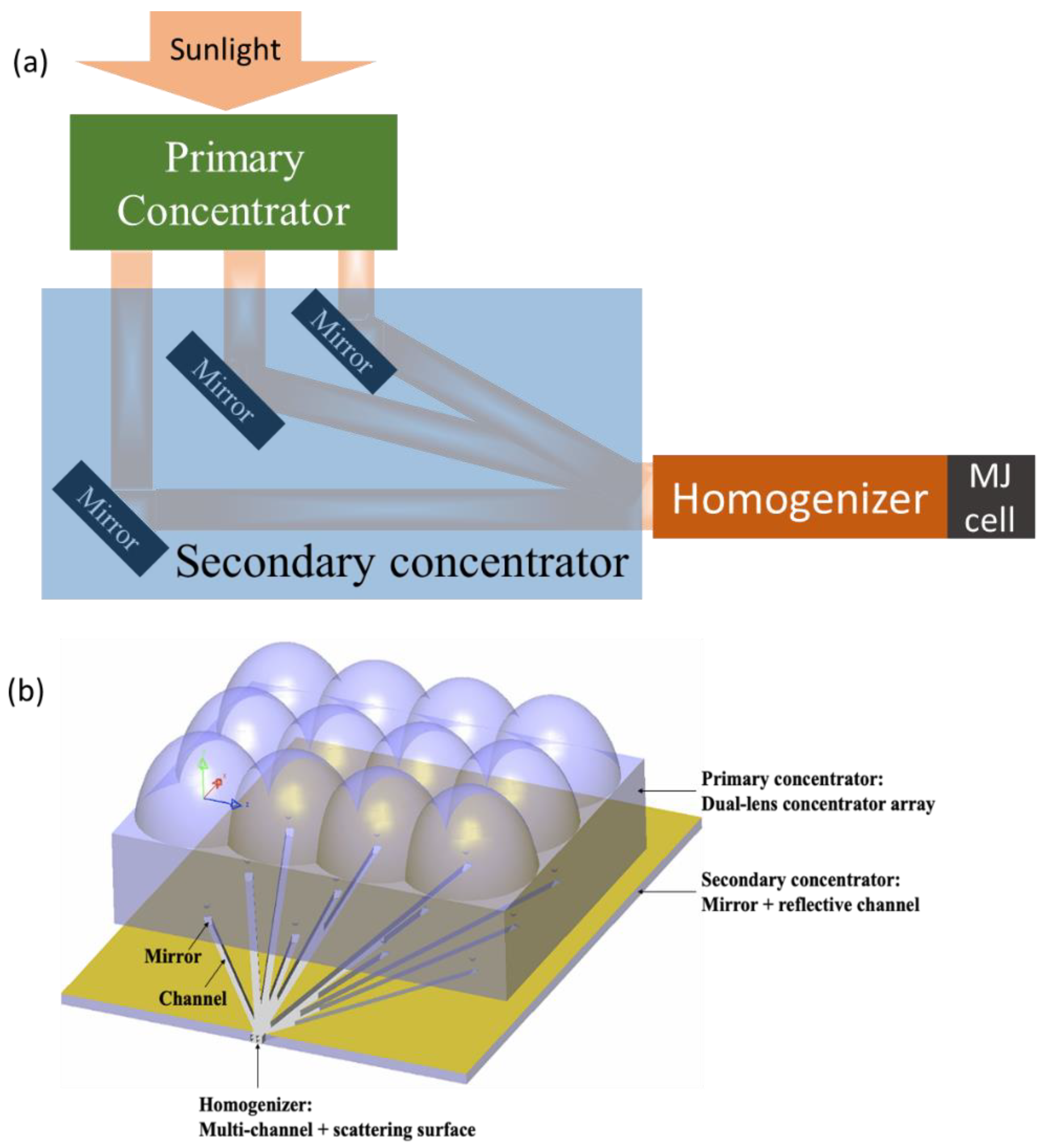
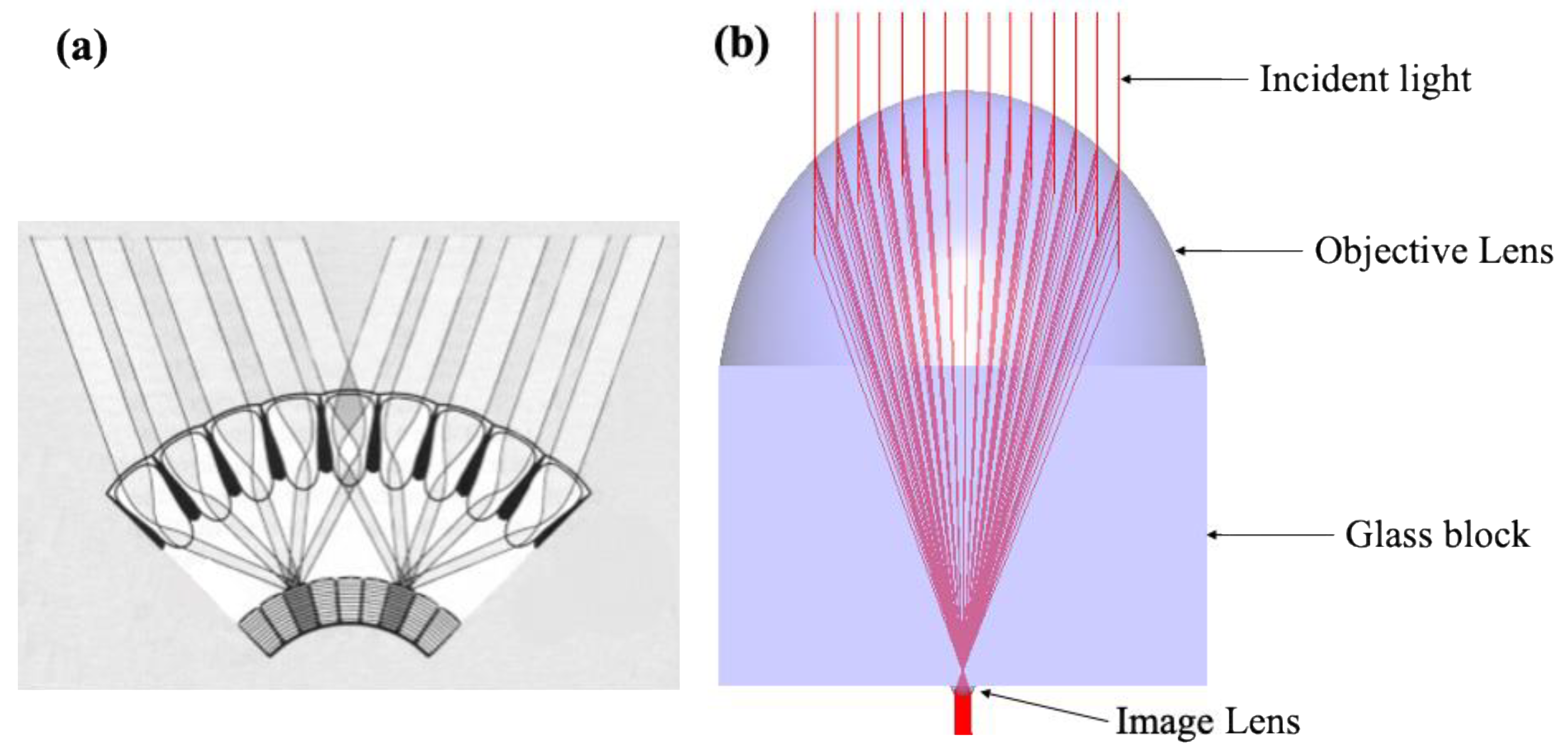

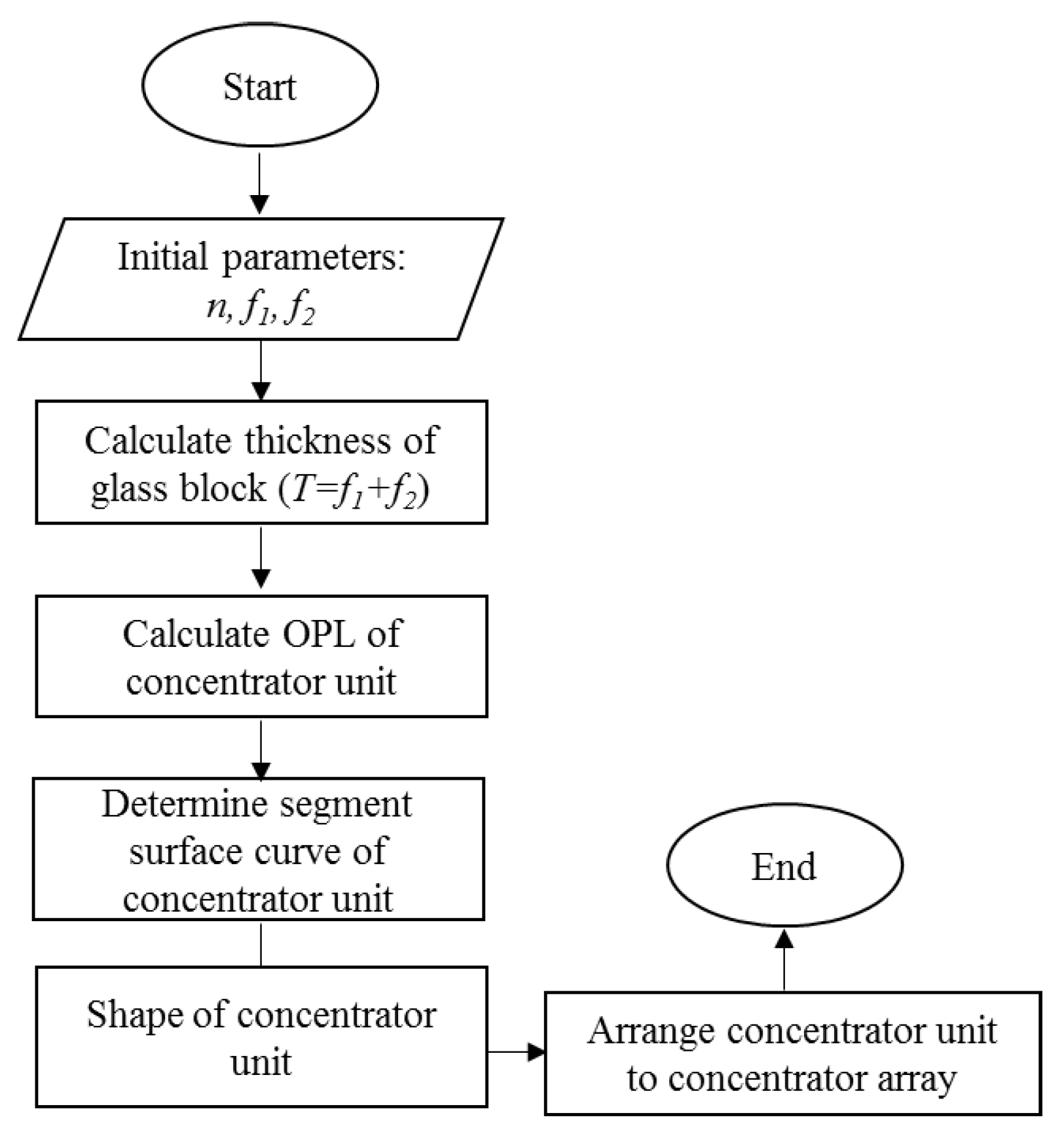
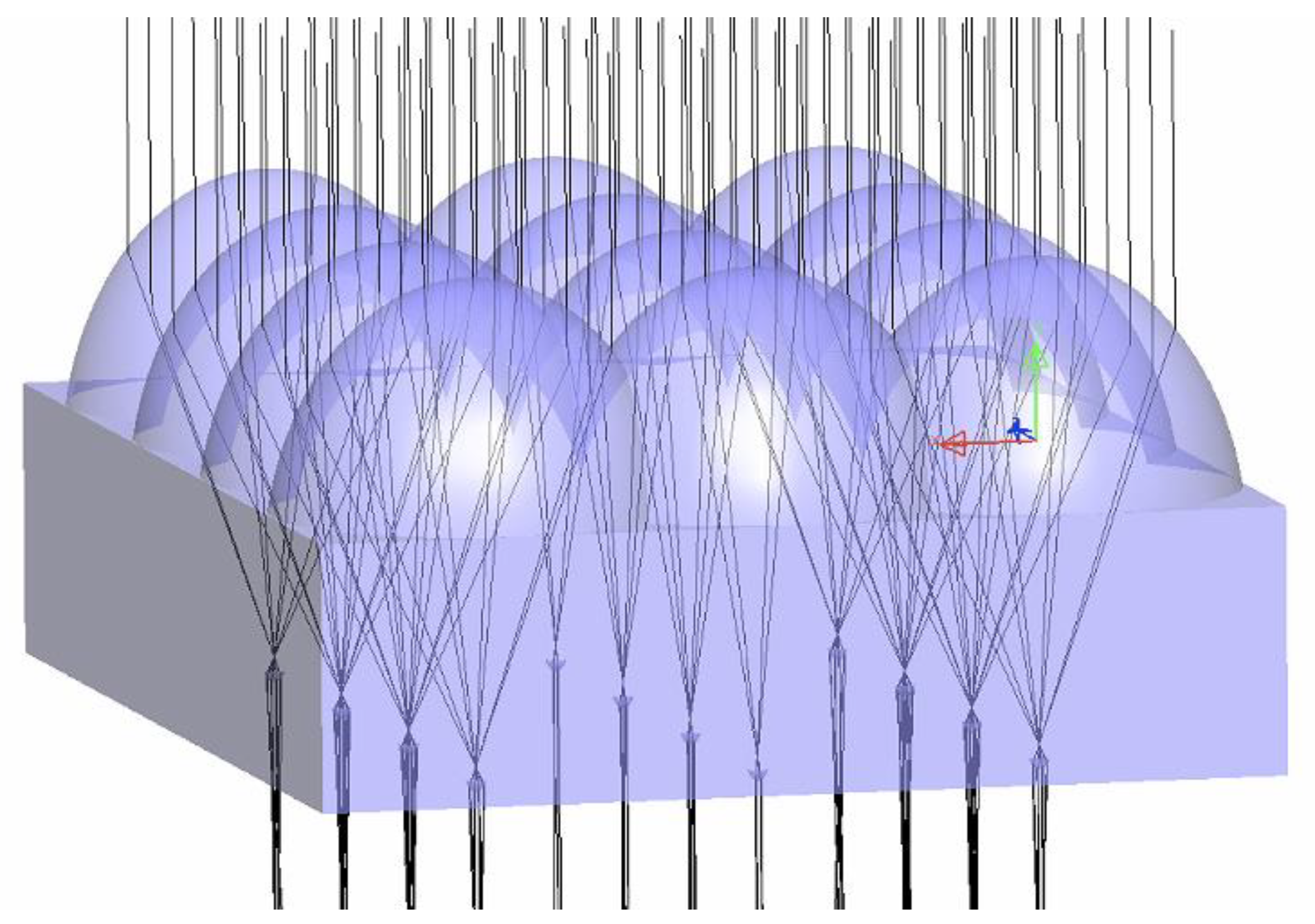
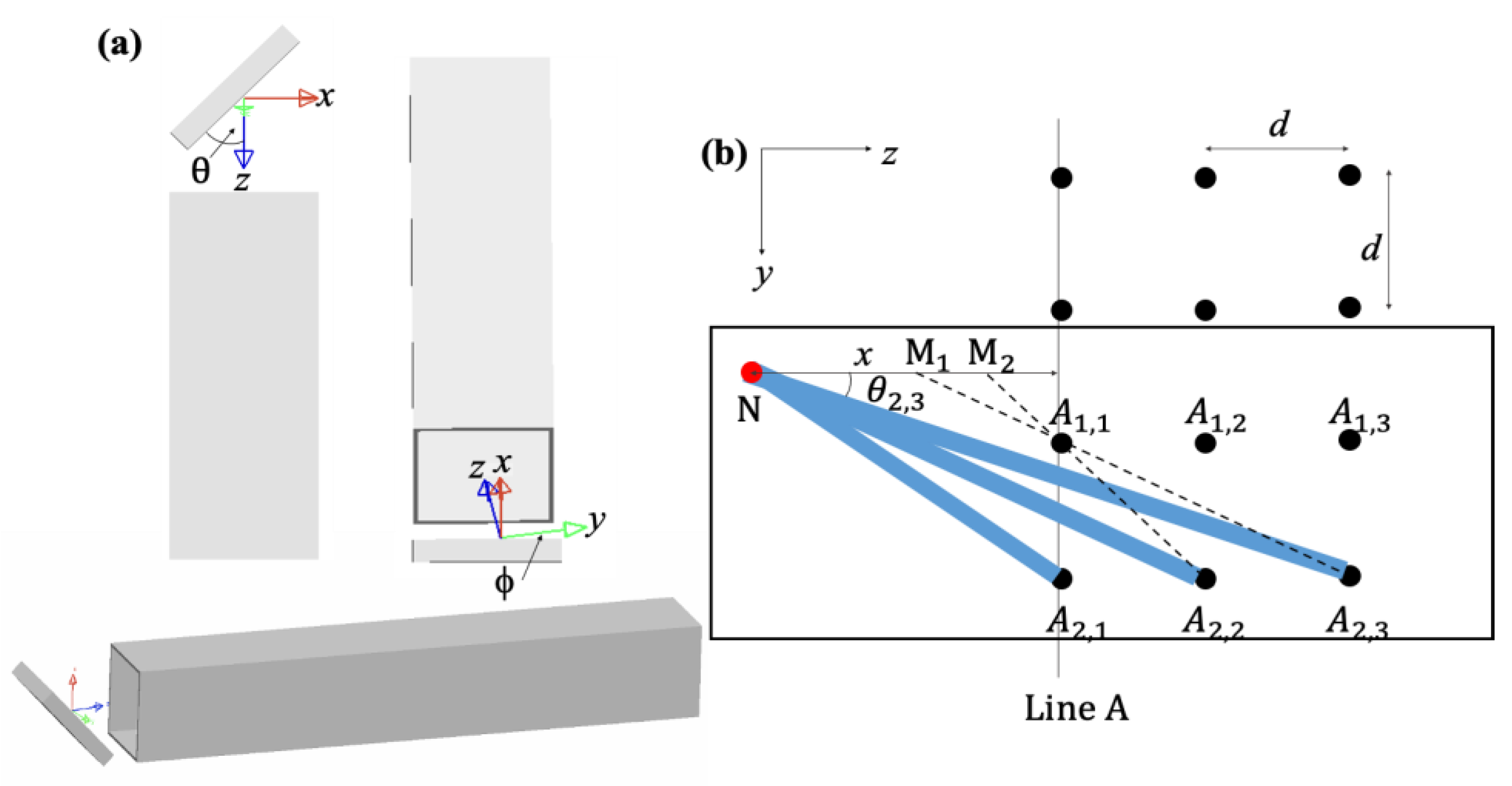

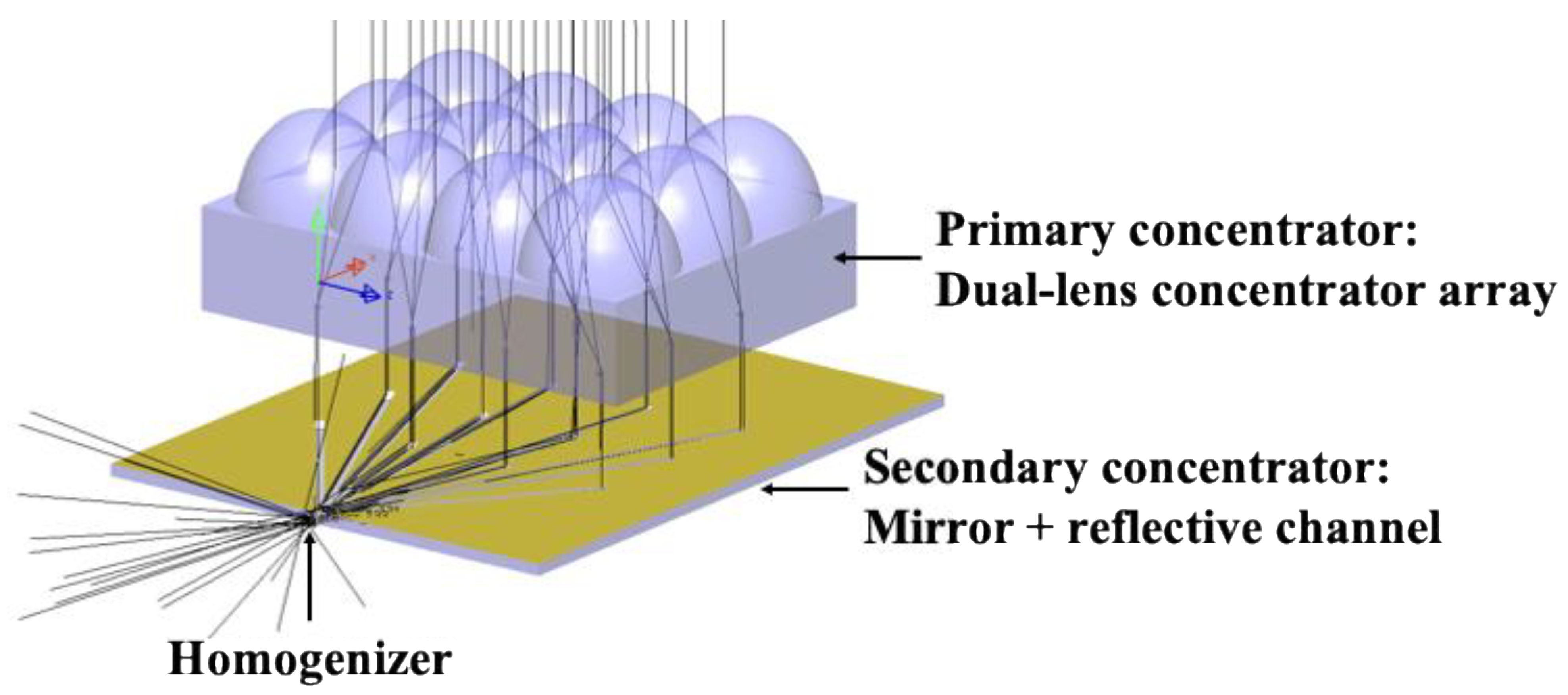
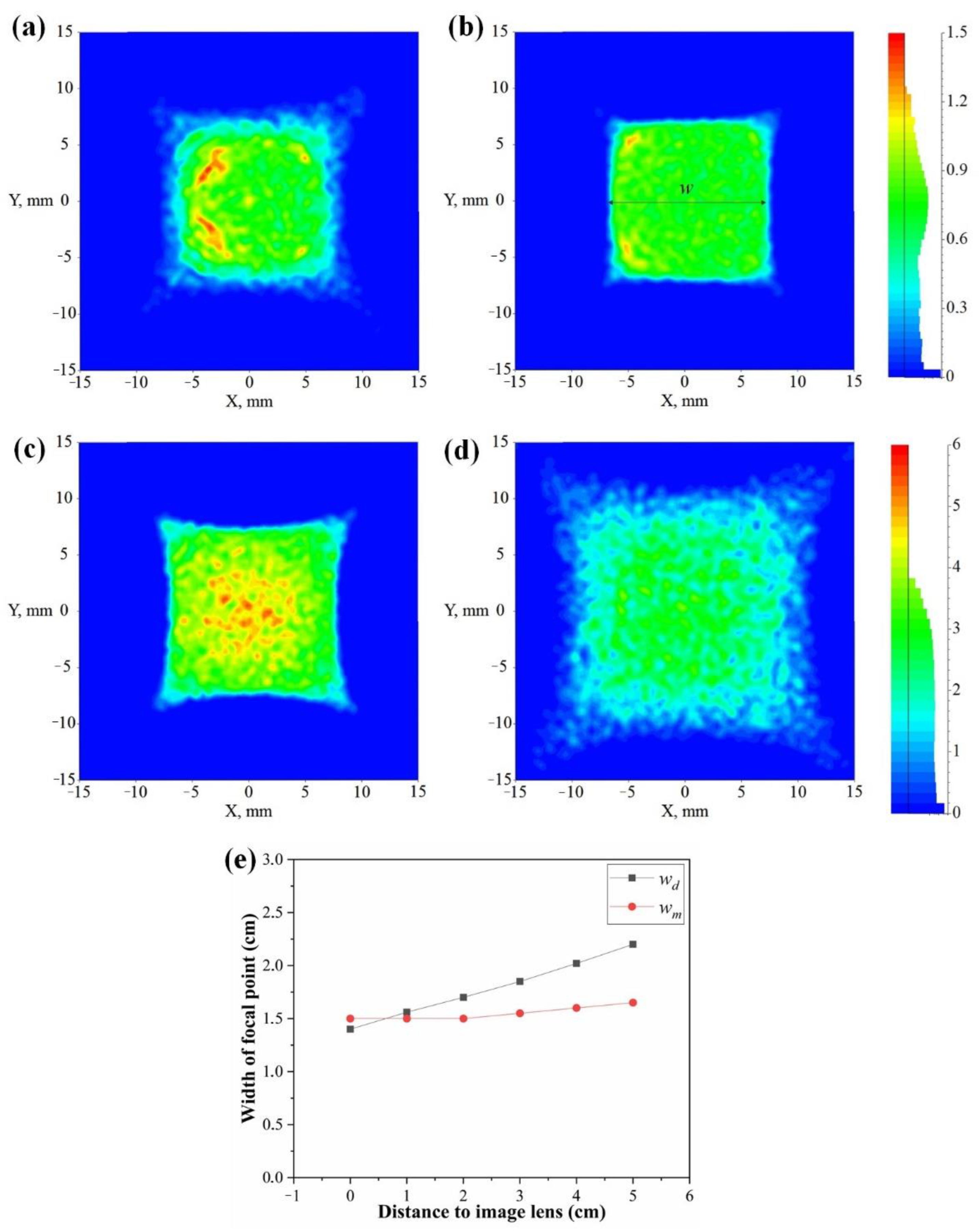
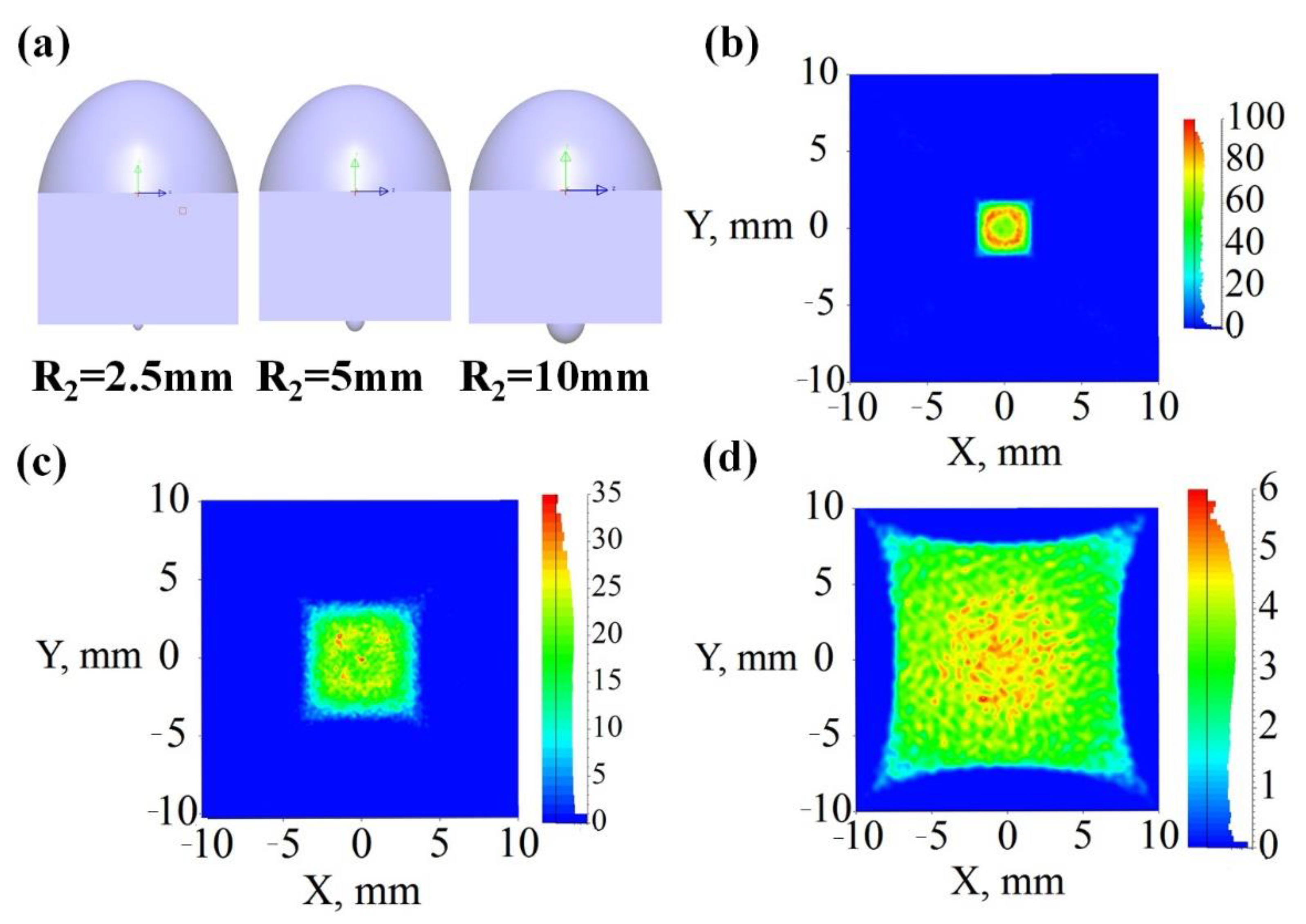
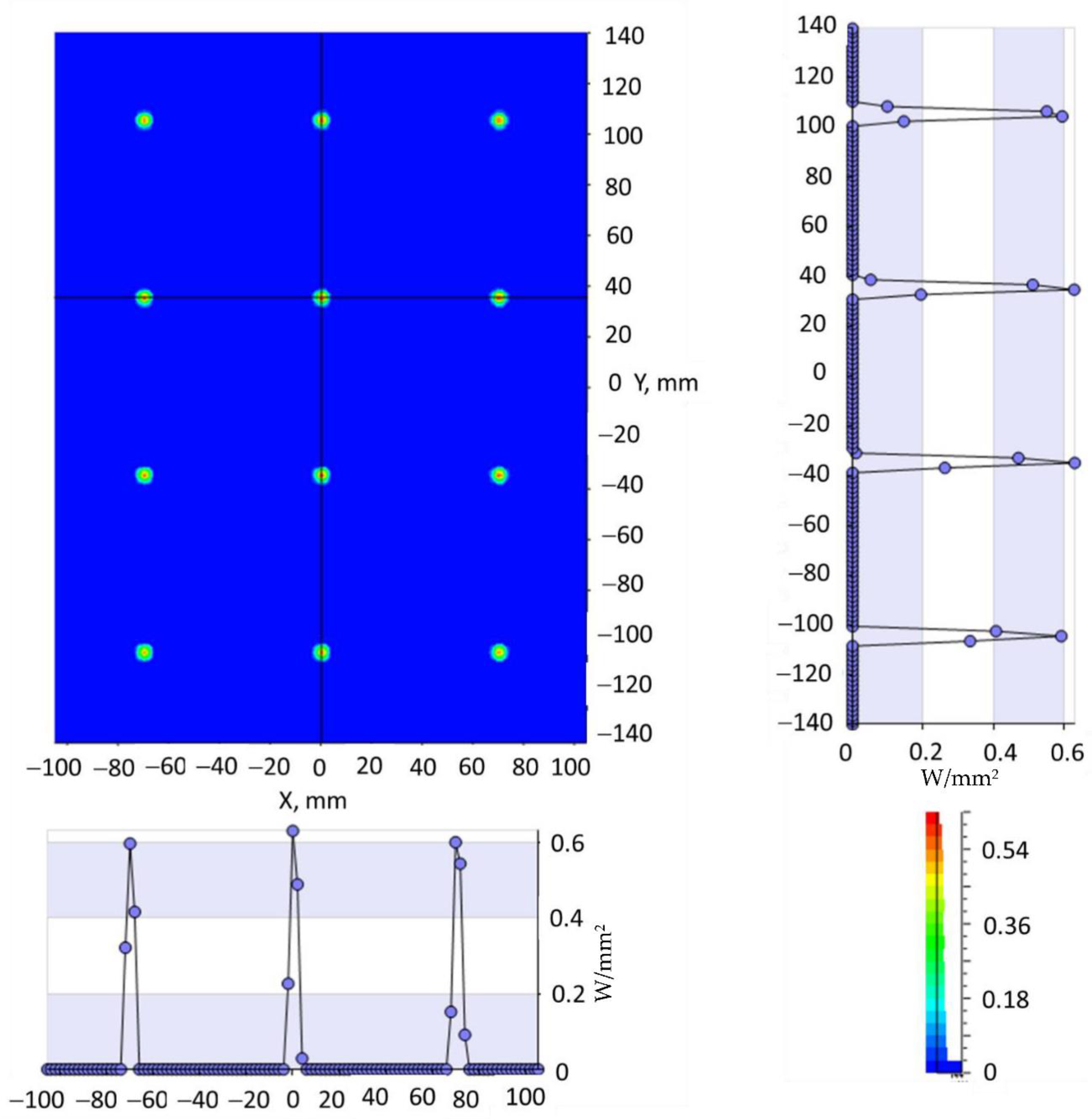




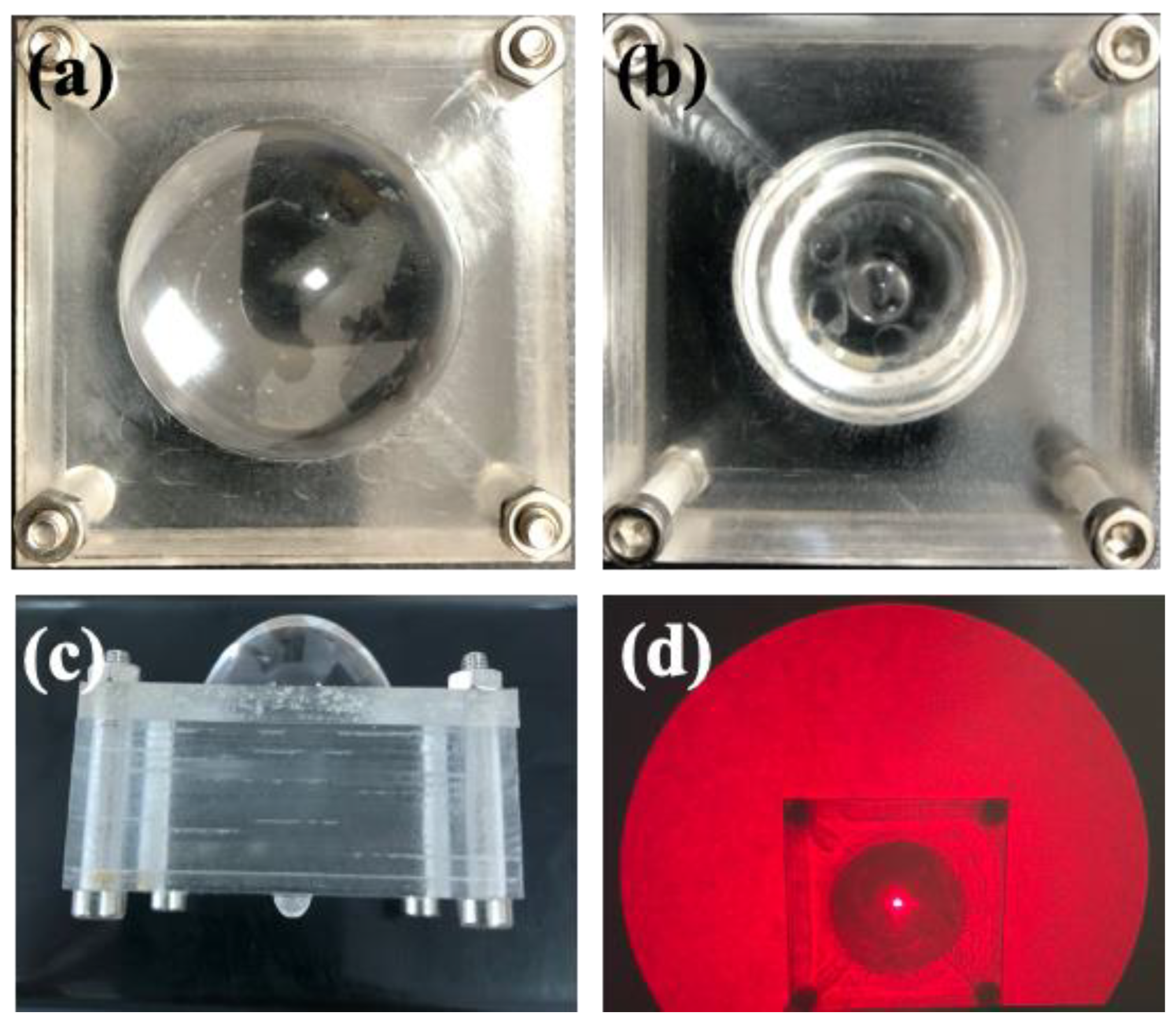
| Design Parameters | |
|---|---|
| Radius of objective lens | 50 mm |
| Radius of image lens | 2.5, 5, 10 mm |
| Number of dual-lens concentrator units | 12 |
| Number of mirrors in secondary concentrator | 12 |
| Number of channels in secondary concentrator | 12 |
| Number of channels in homogenizer | 4 |
Publisher’s Note: MDPI stays neutral with regard to jurisdictional claims in published maps and institutional affiliations. |
© 2022 by the authors. Licensee MDPI, Basel, Switzerland. This article is an open access article distributed under the terms and conditions of the Creative Commons Attribution (CC BY) license (https://creativecommons.org/licenses/by/4.0/).
Share and Cite
Vu, D.T.; Kieu, N.M.; Tien, T.Q.; Nguyen, T.P.; Vu, H.; Shin, S.; Vu, N.H. Solar Concentrator Bio-Inspired by the Superposition Compound Eye for High-Concentration Photovoltaic System up to Thousands Fold Factor. Energies 2022, 15, 3406. https://doi.org/10.3390/en15093406
Vu DT, Kieu NM, Tien TQ, Nguyen TP, Vu H, Shin S, Vu NH. Solar Concentrator Bio-Inspired by the Superposition Compound Eye for High-Concentration Photovoltaic System up to Thousands Fold Factor. Energies. 2022; 15(9):3406. https://doi.org/10.3390/en15093406
Chicago/Turabian StyleVu, Duc Tu, Ngoc Minh Kieu, Tran Quoc Tien, Thanh Phuong Nguyen, Hoang Vu, Seoyong Shin, and Ngoc Hai Vu. 2022. "Solar Concentrator Bio-Inspired by the Superposition Compound Eye for High-Concentration Photovoltaic System up to Thousands Fold Factor" Energies 15, no. 9: 3406. https://doi.org/10.3390/en15093406






